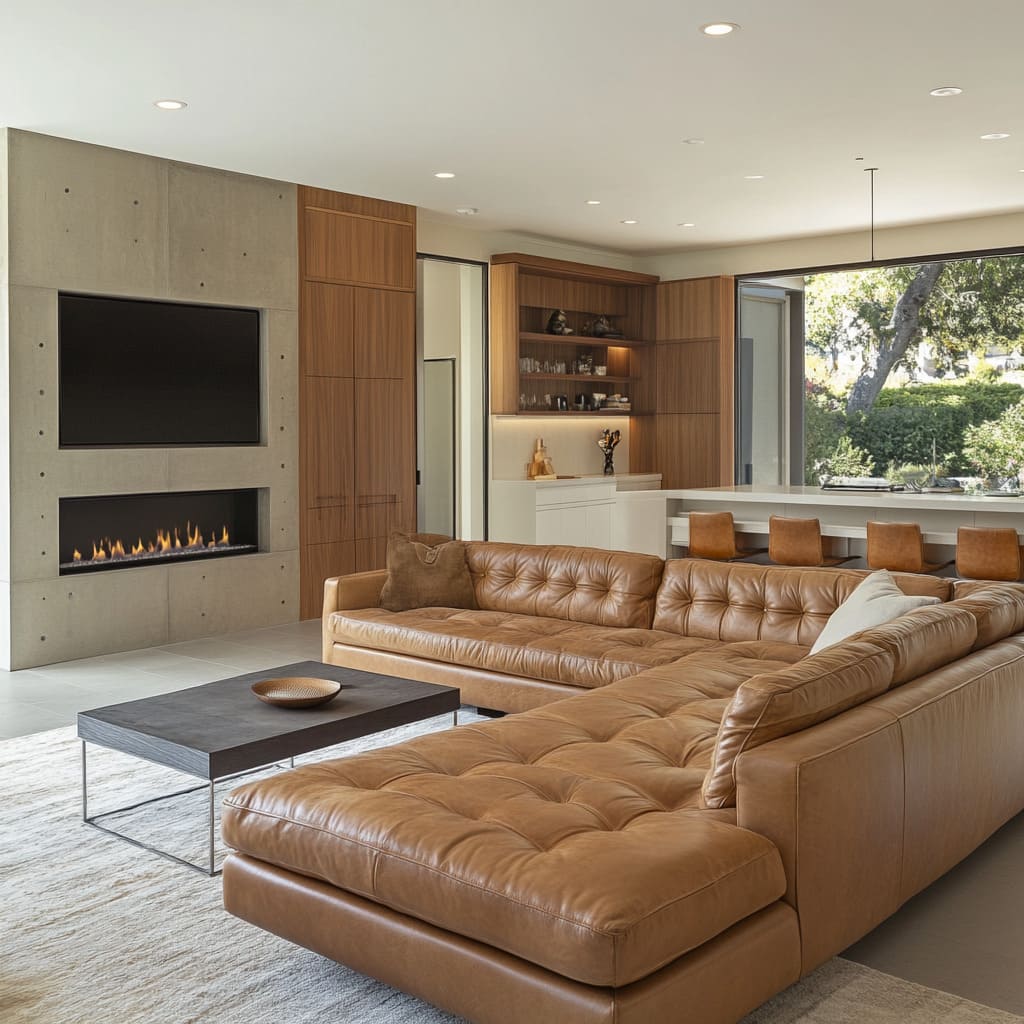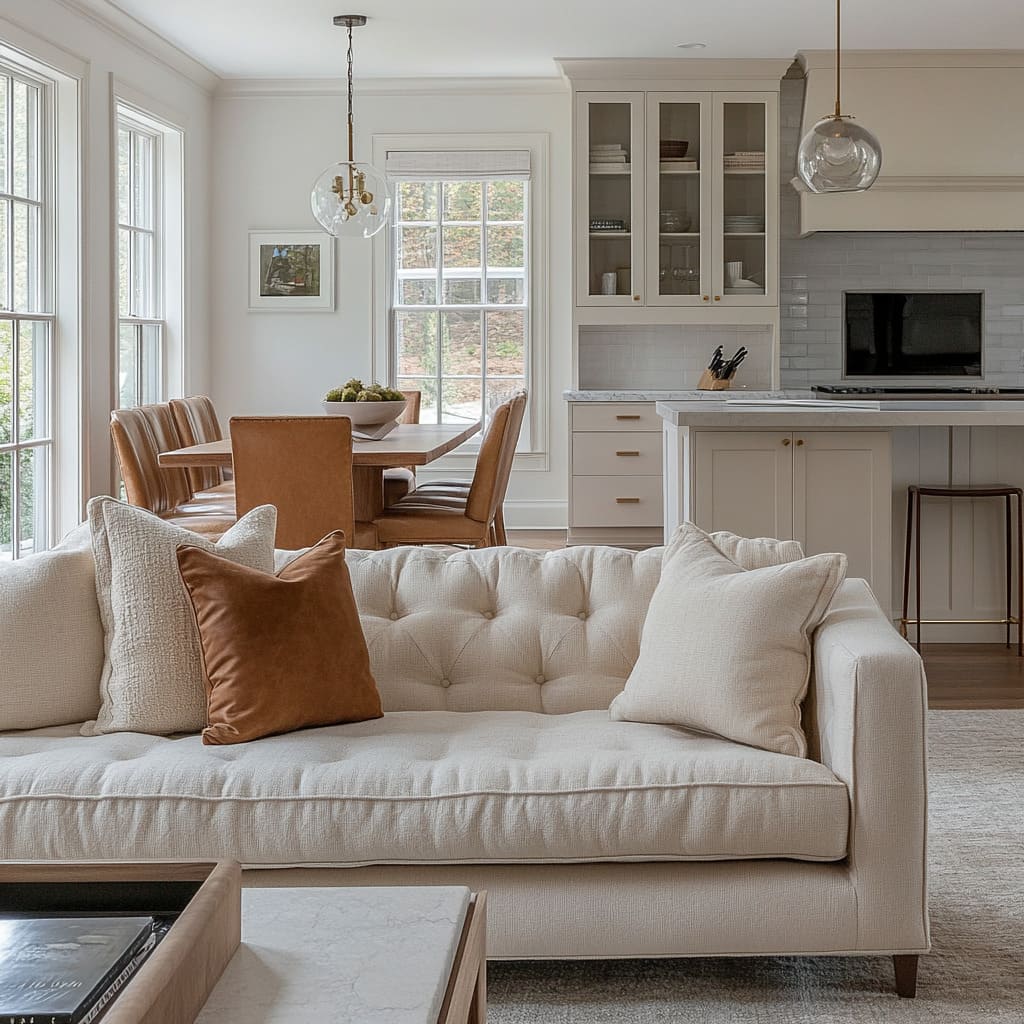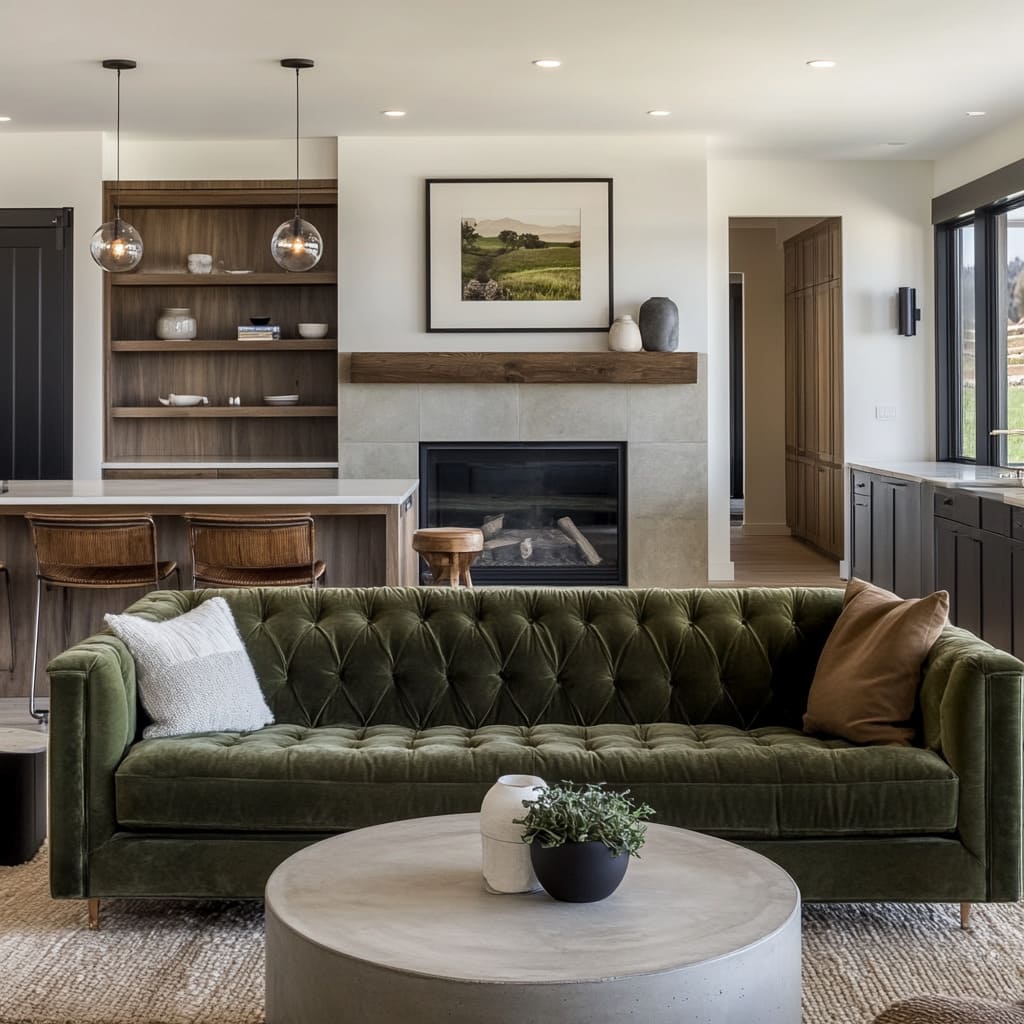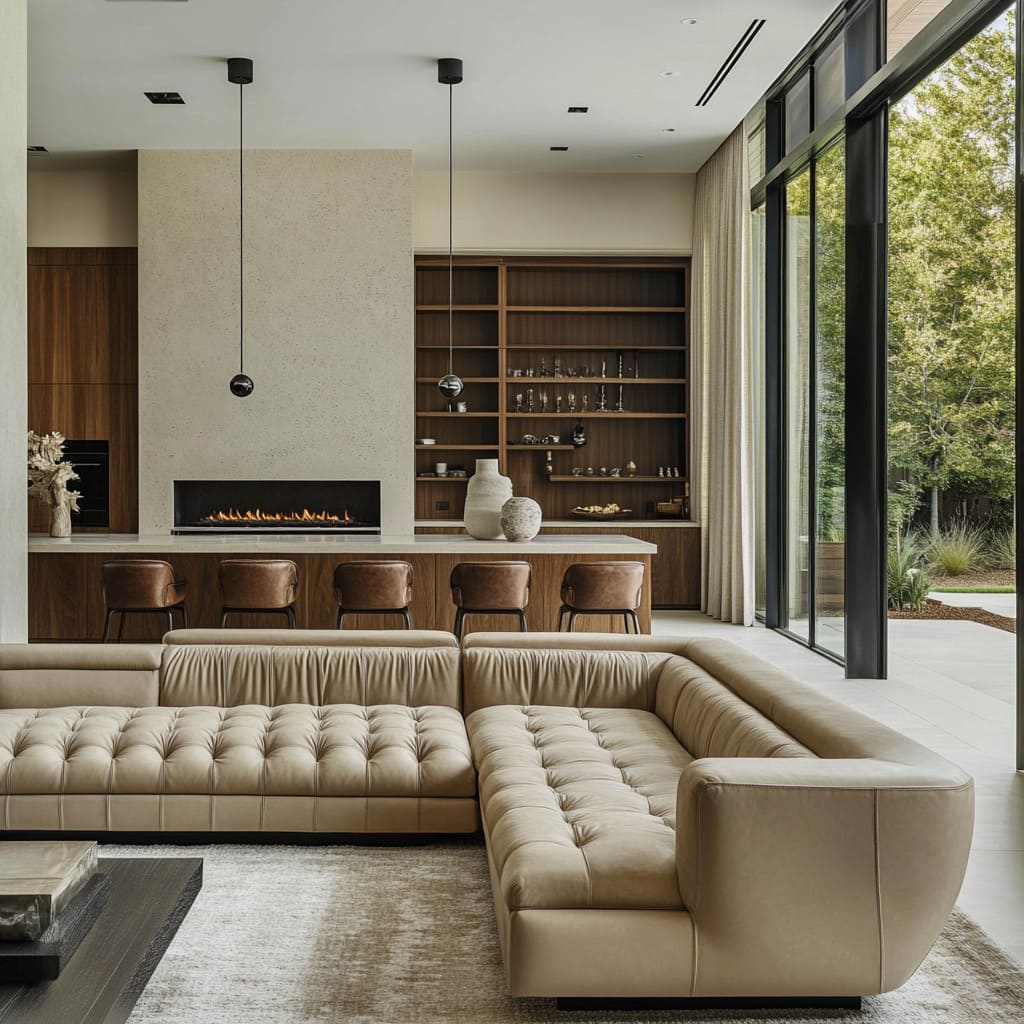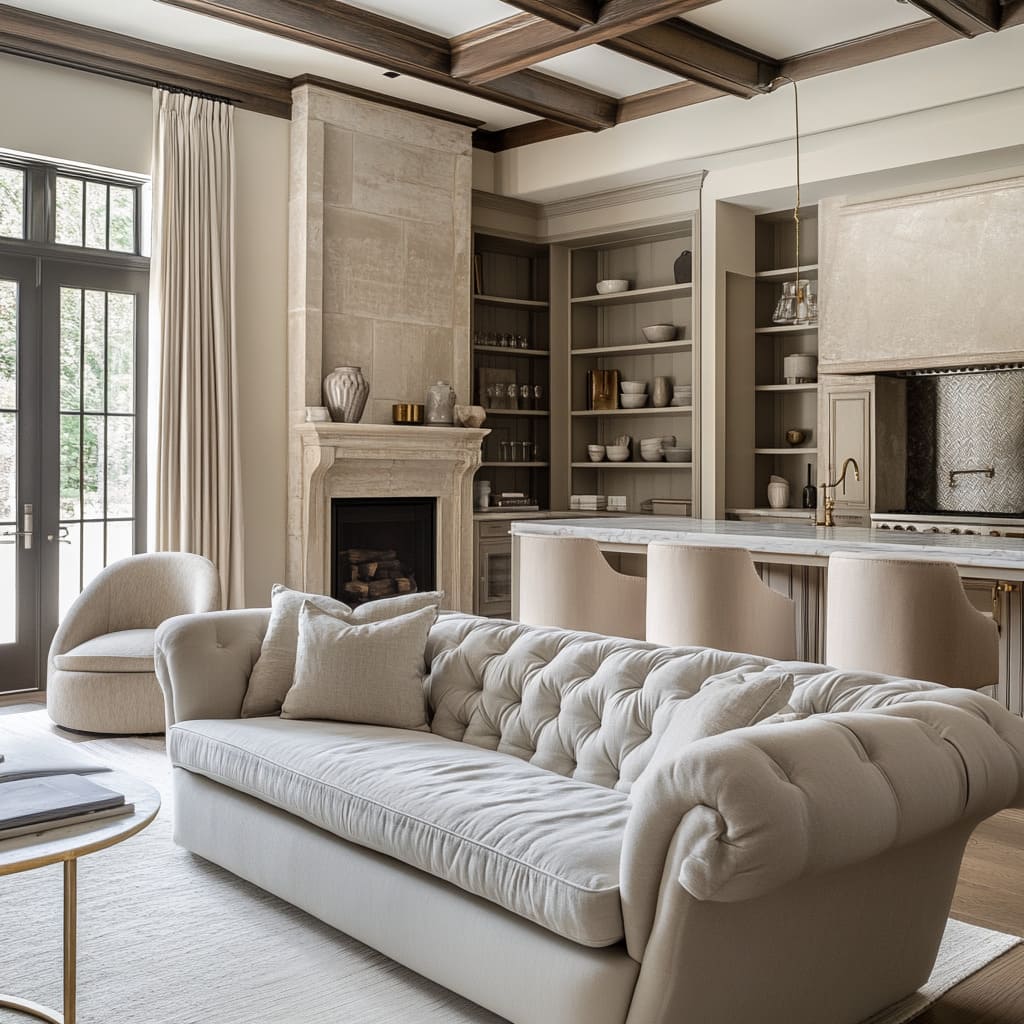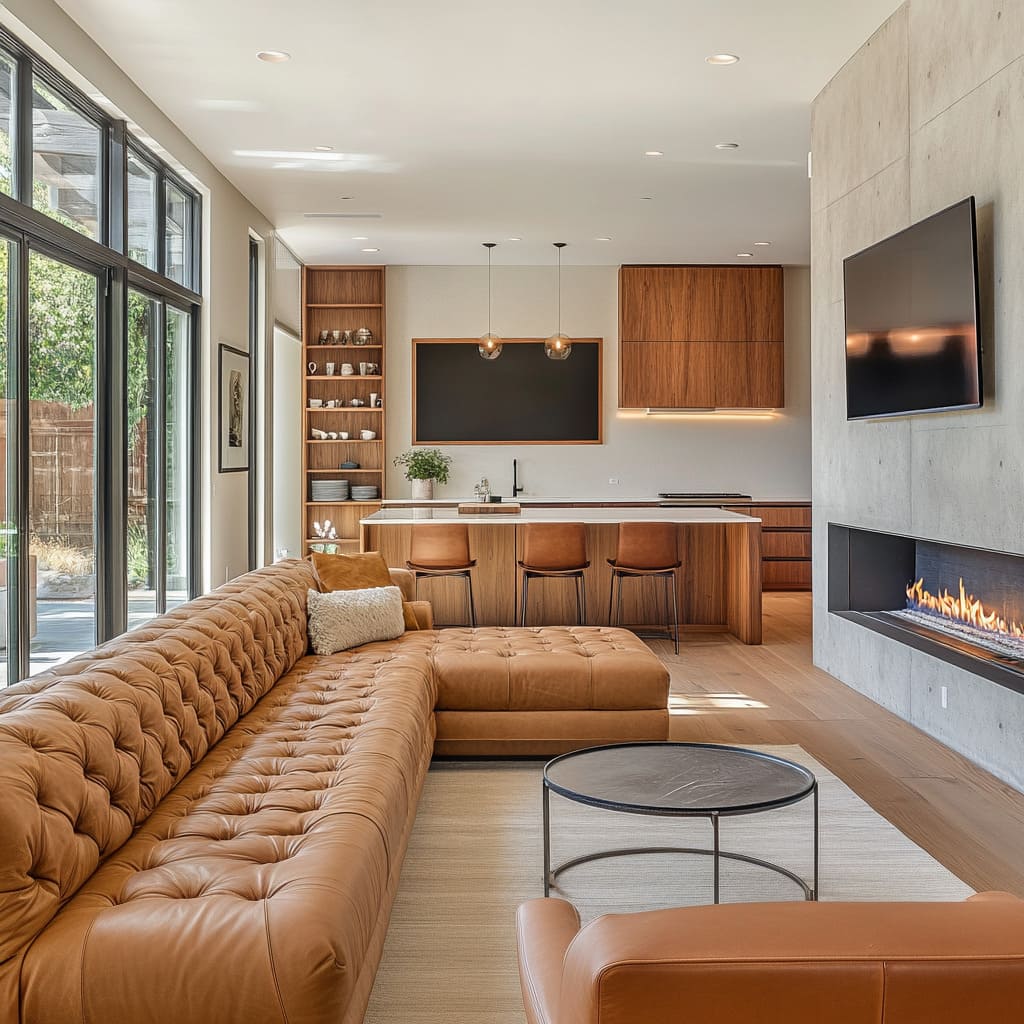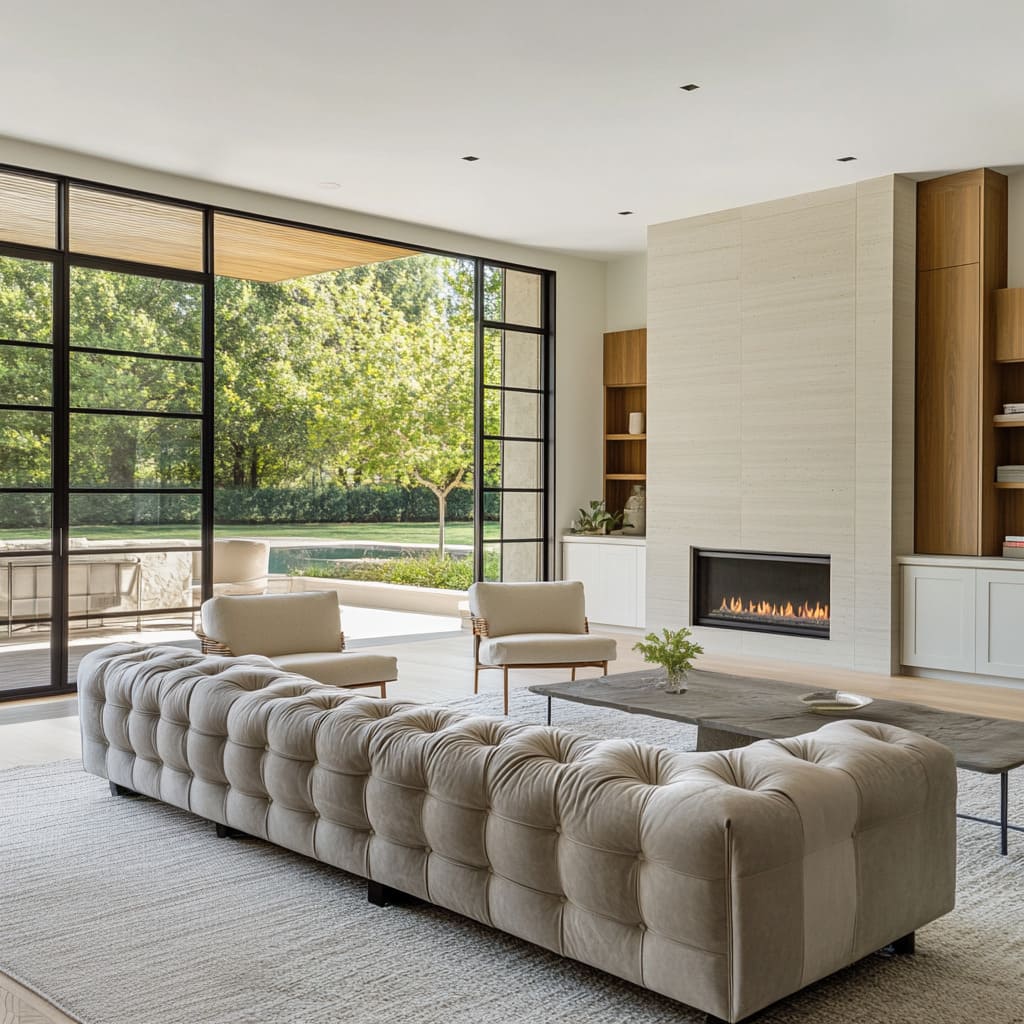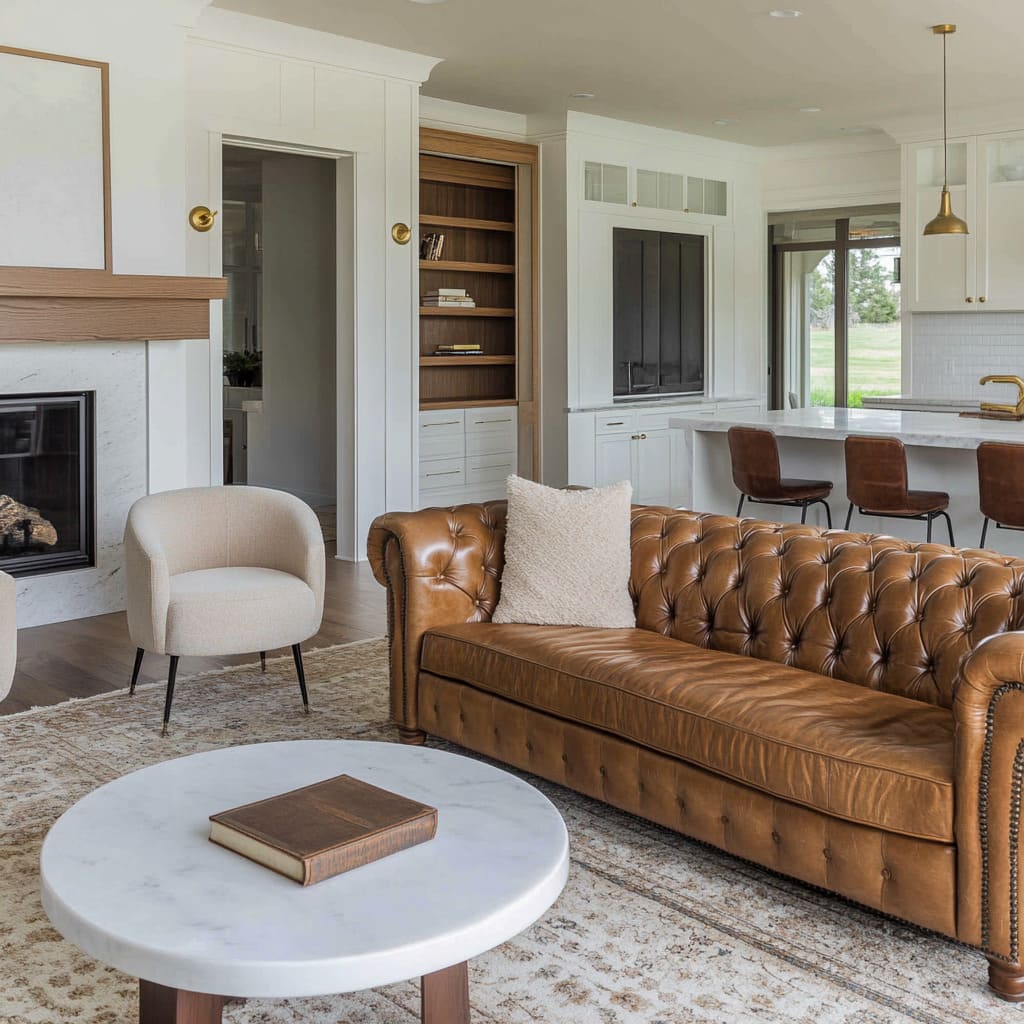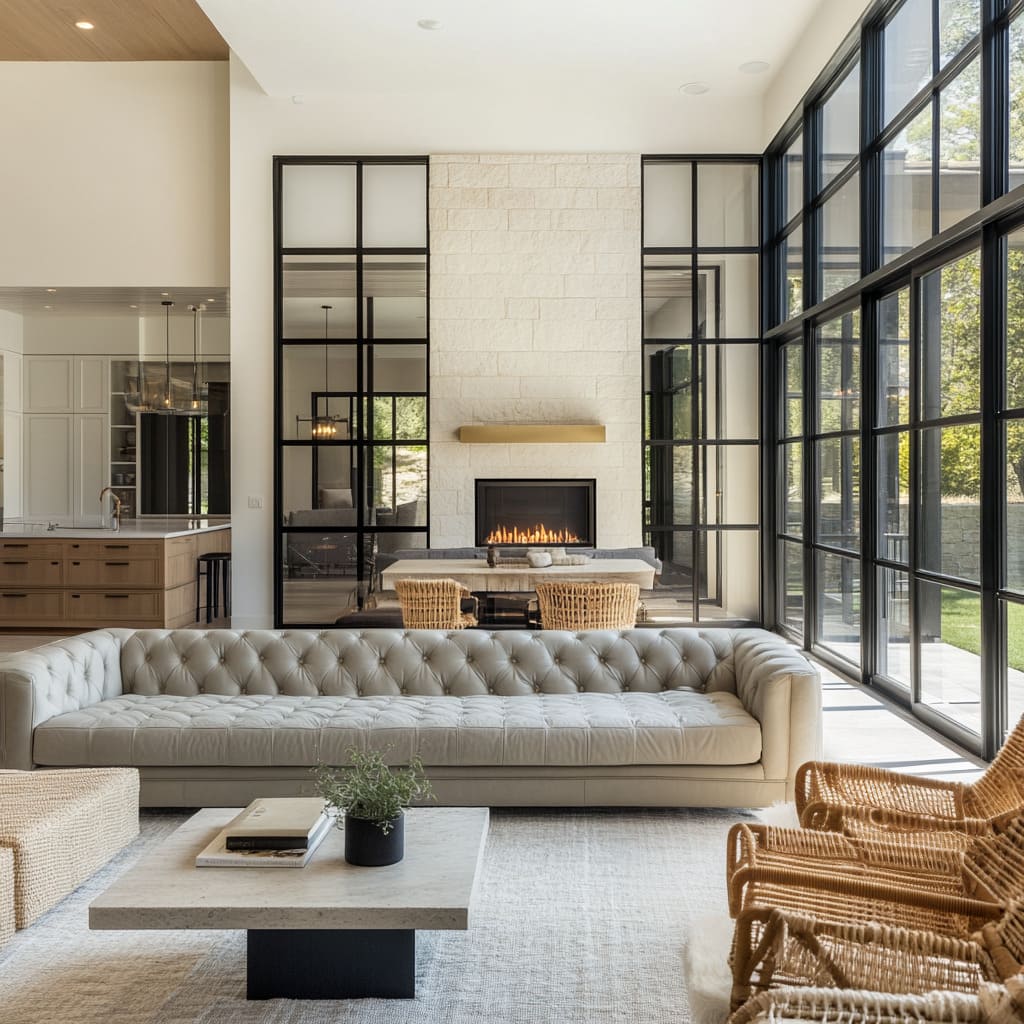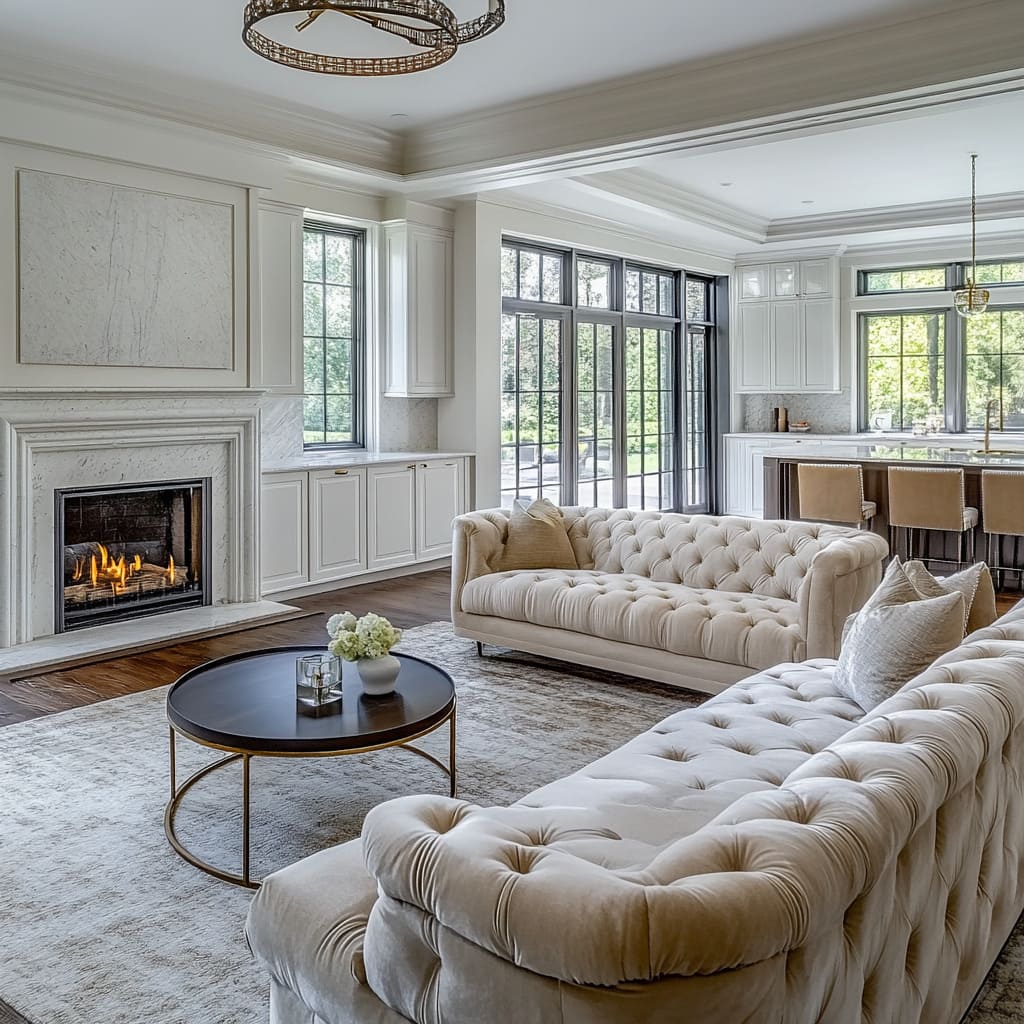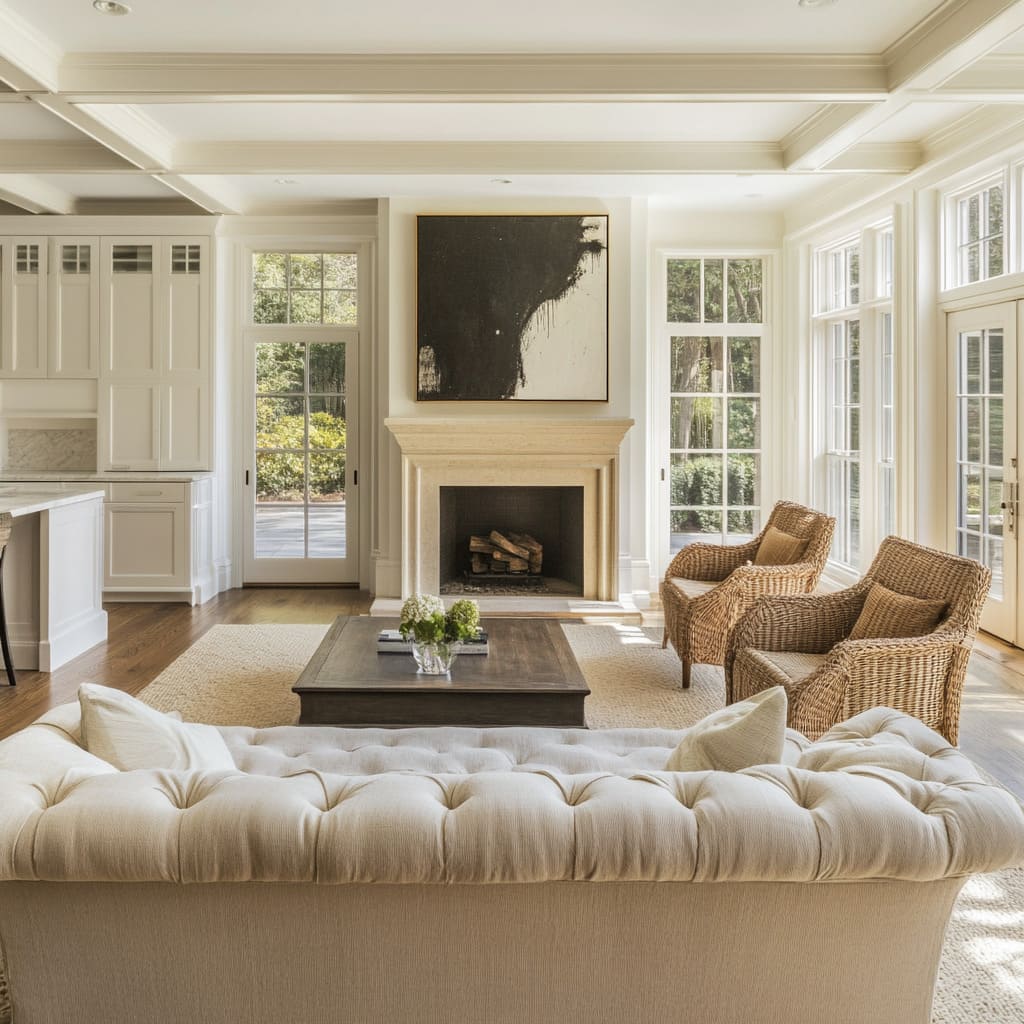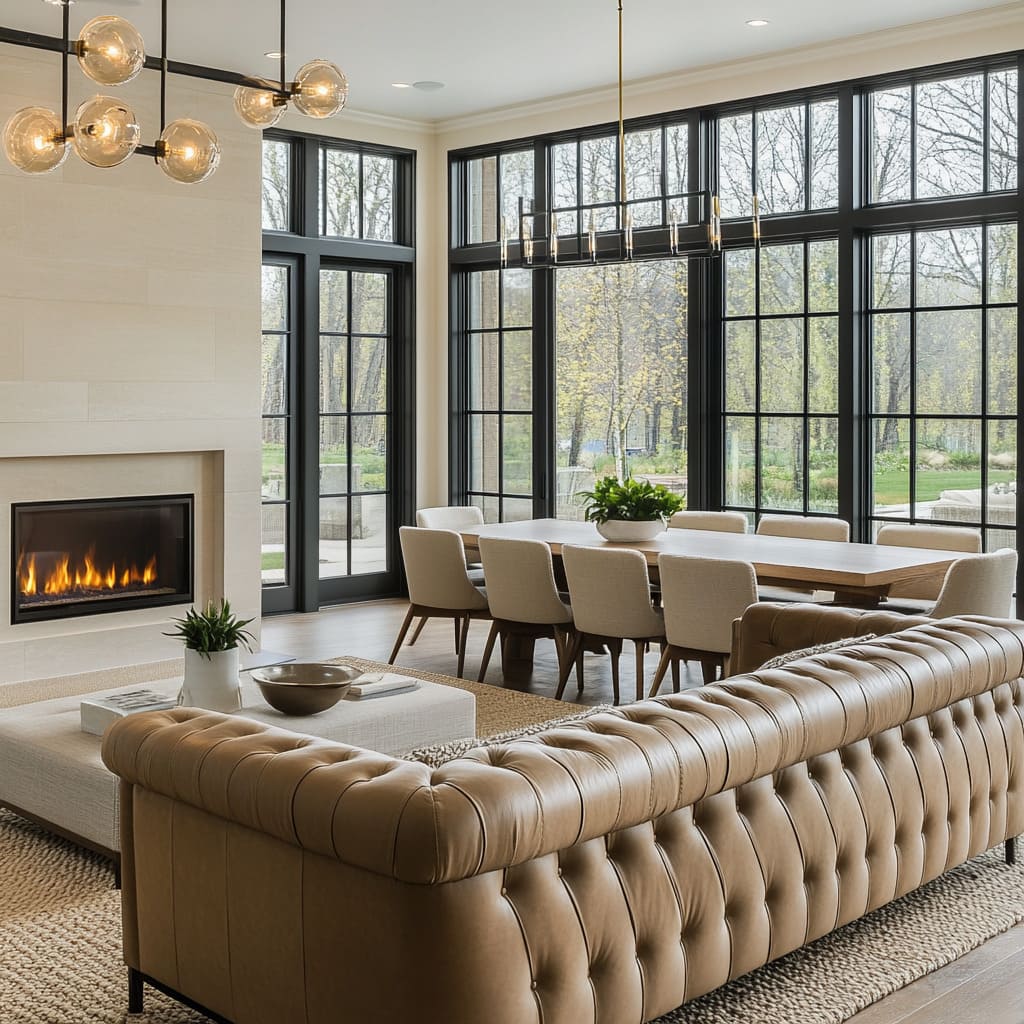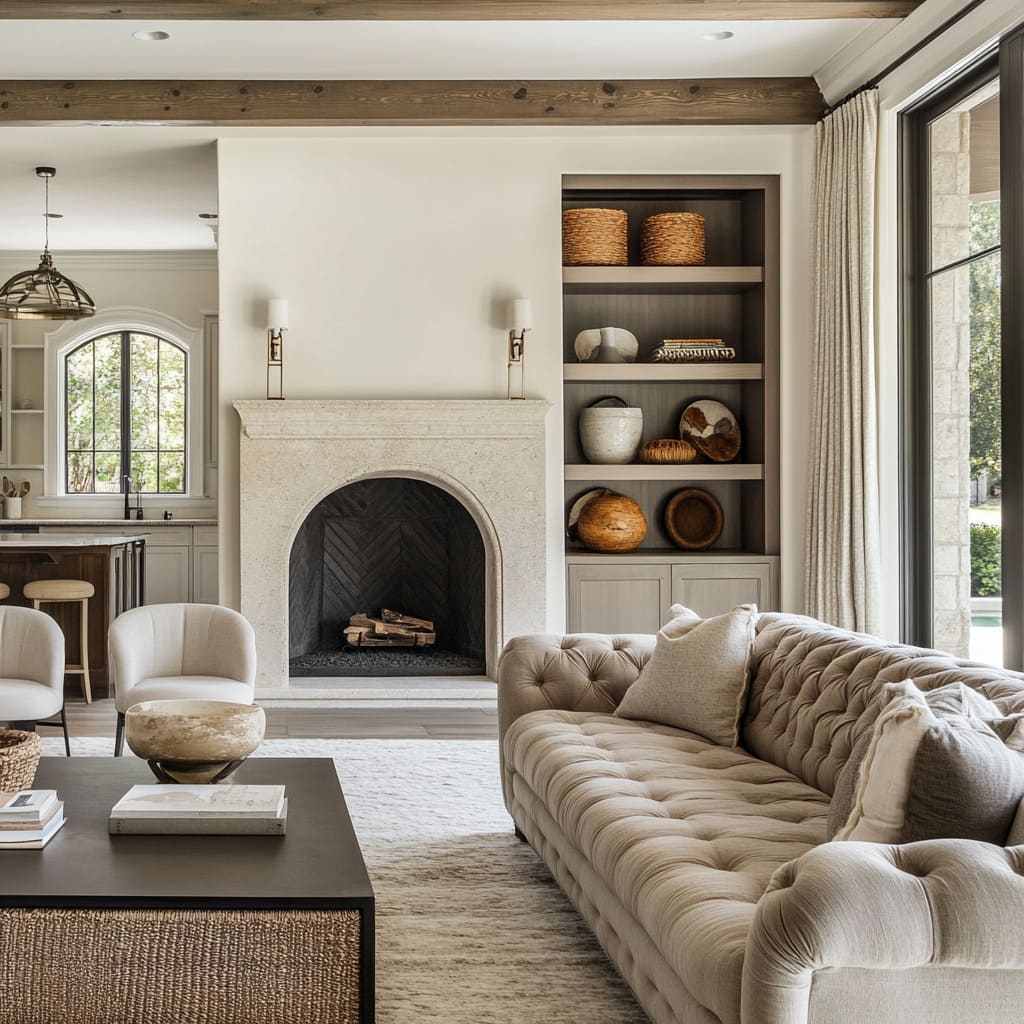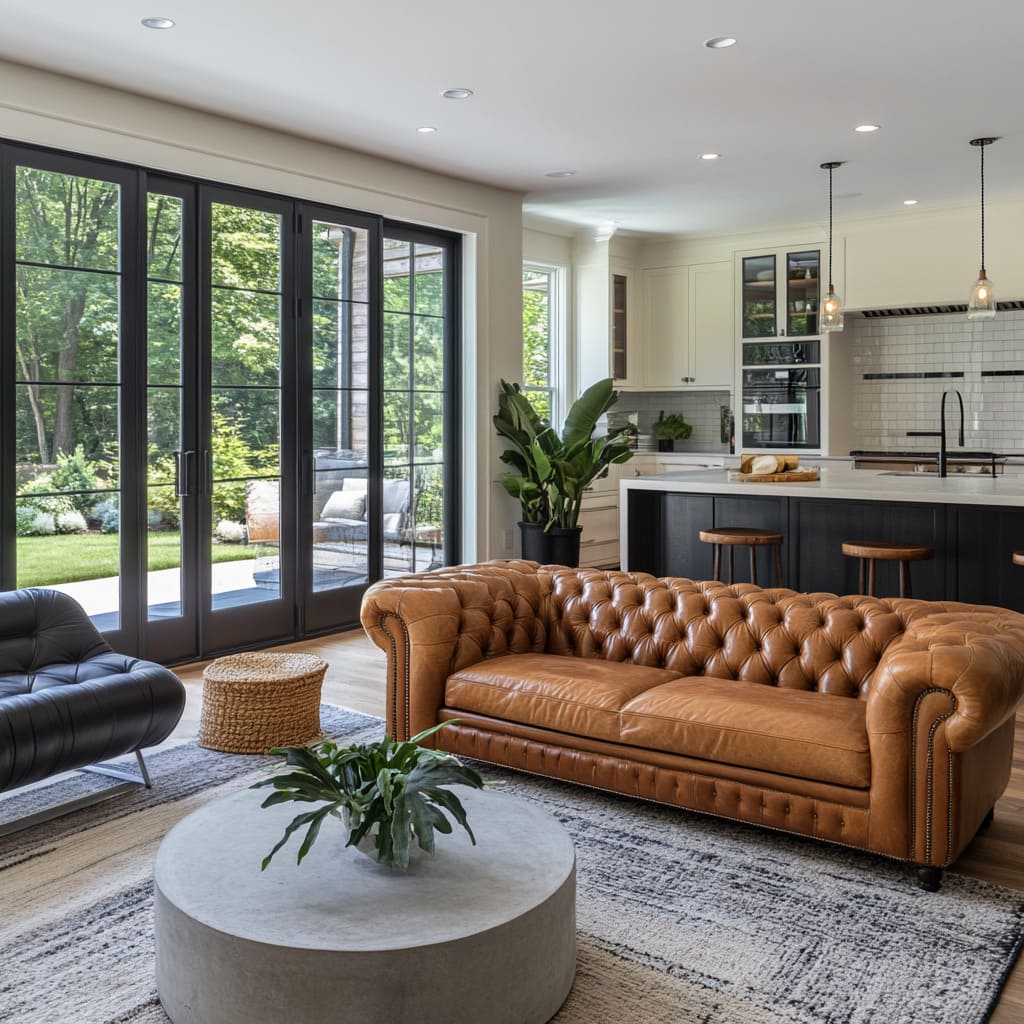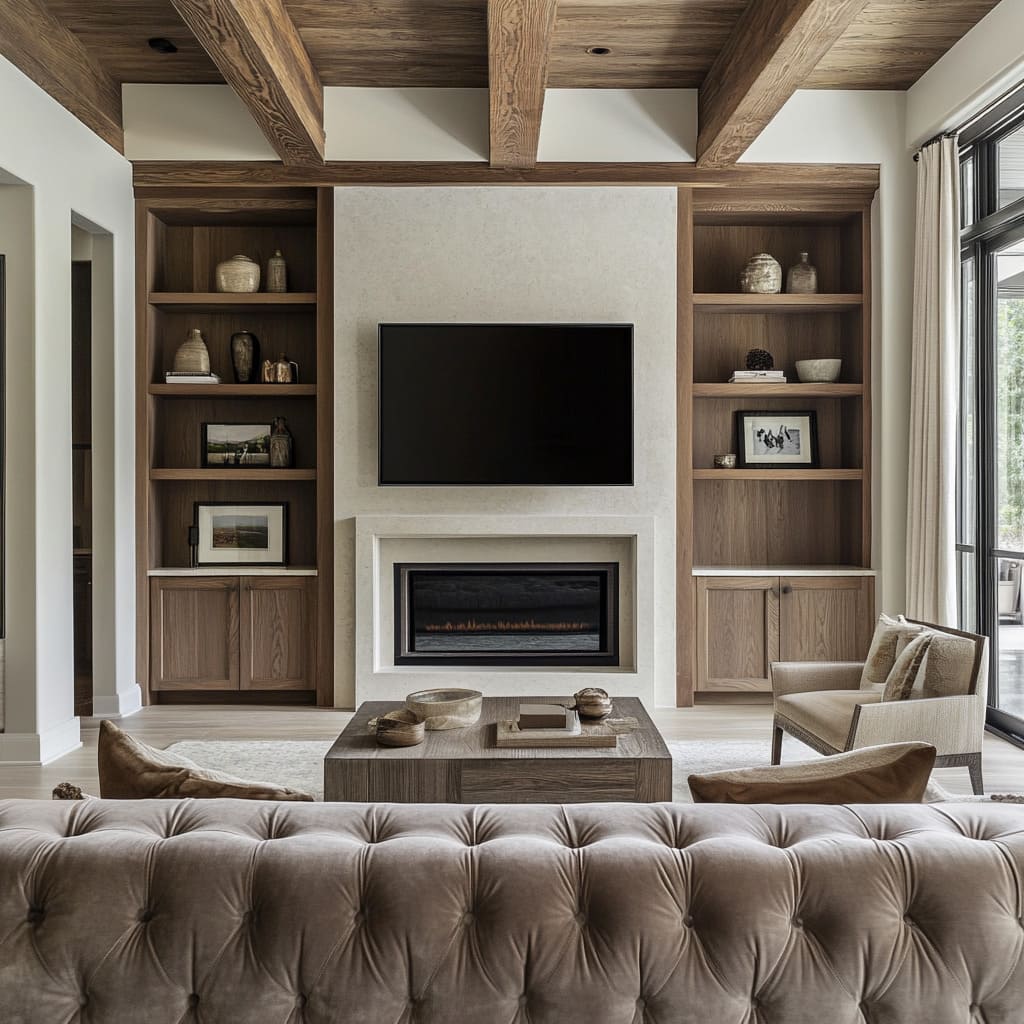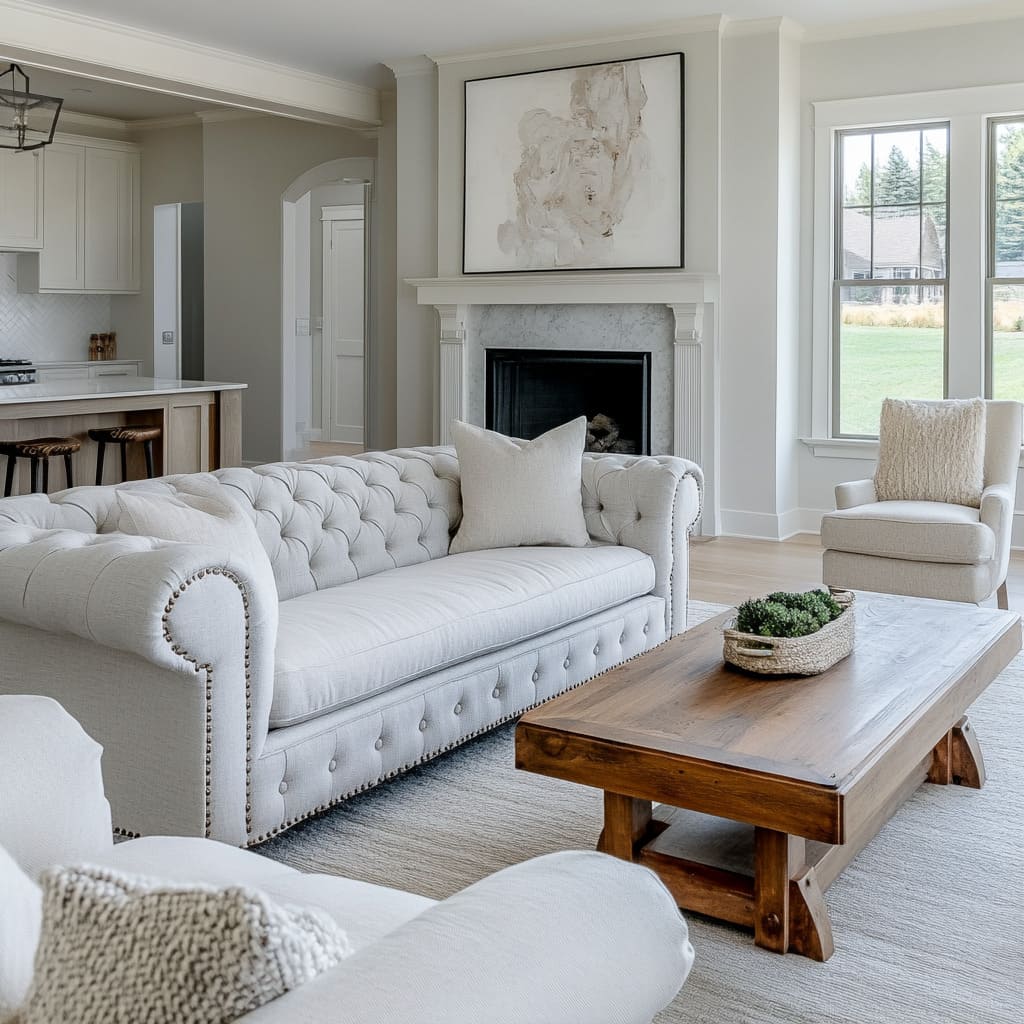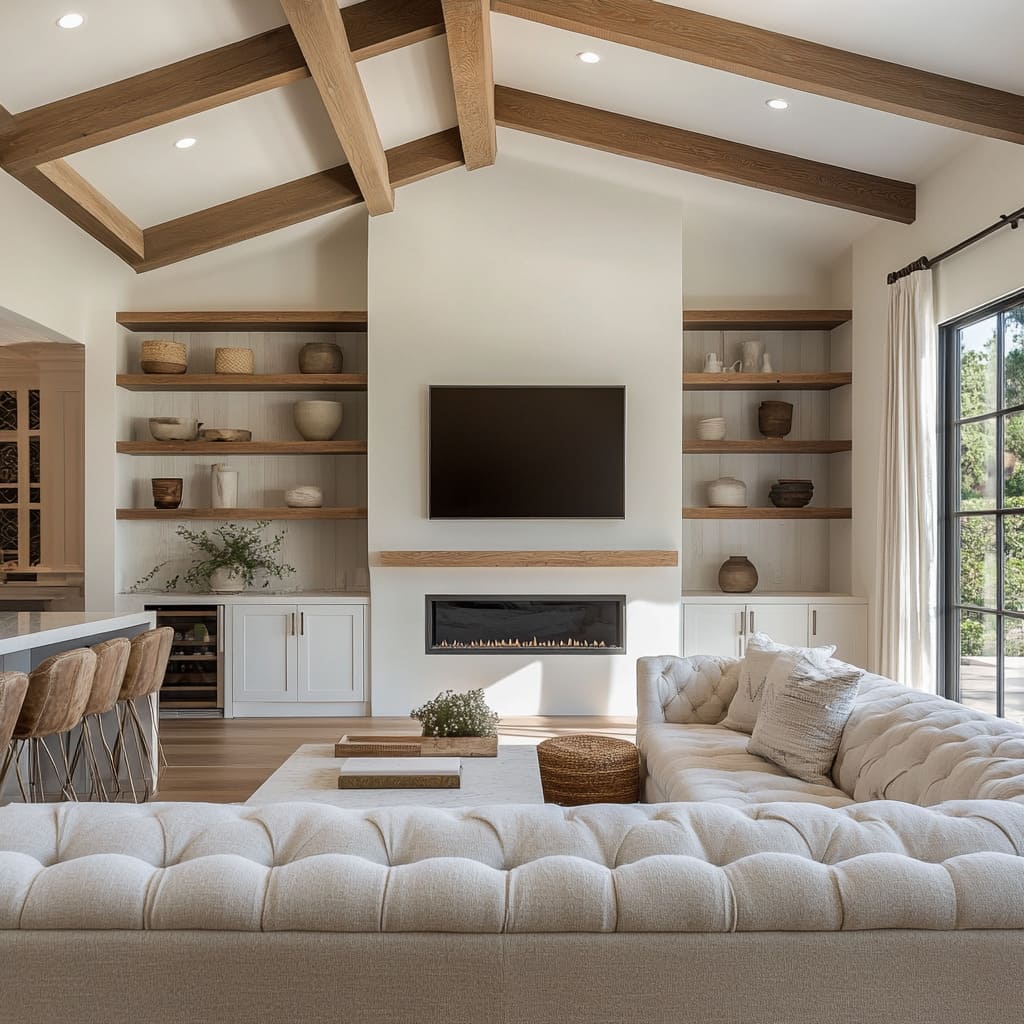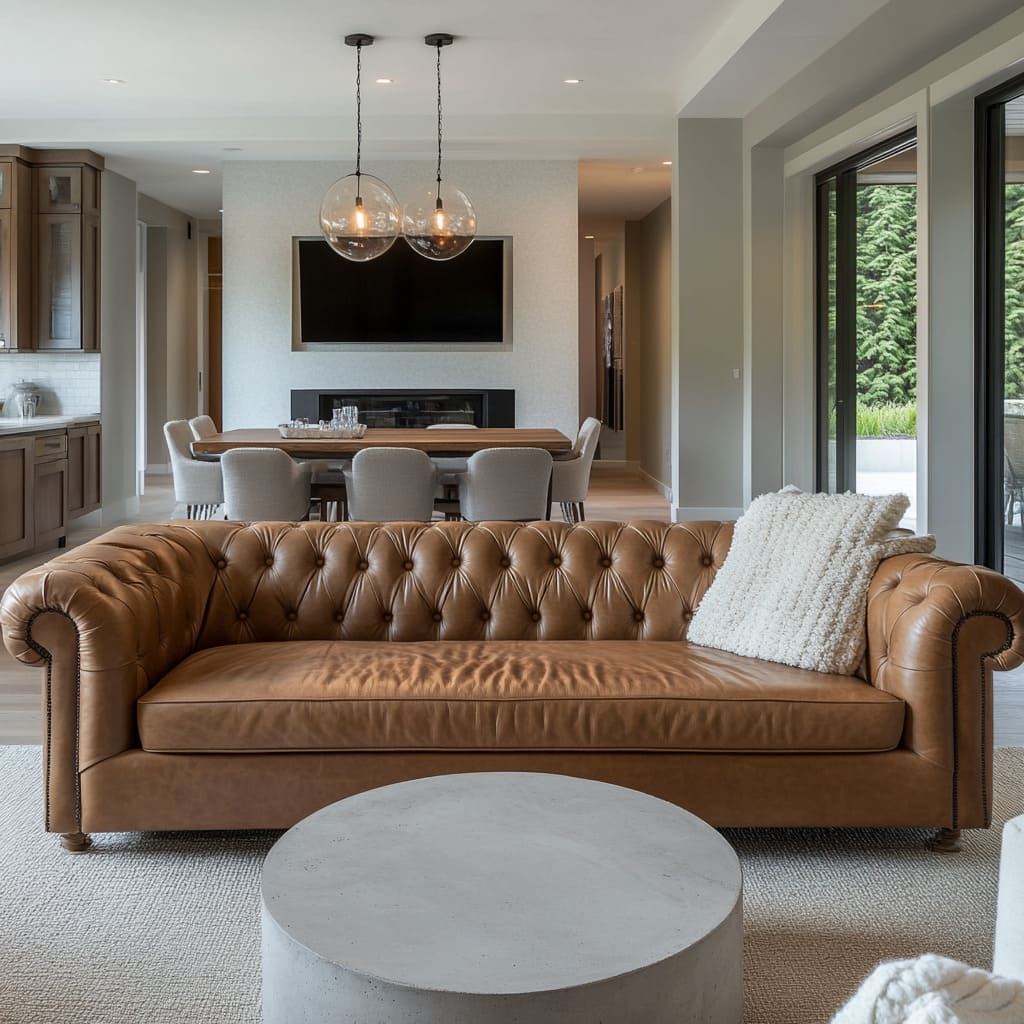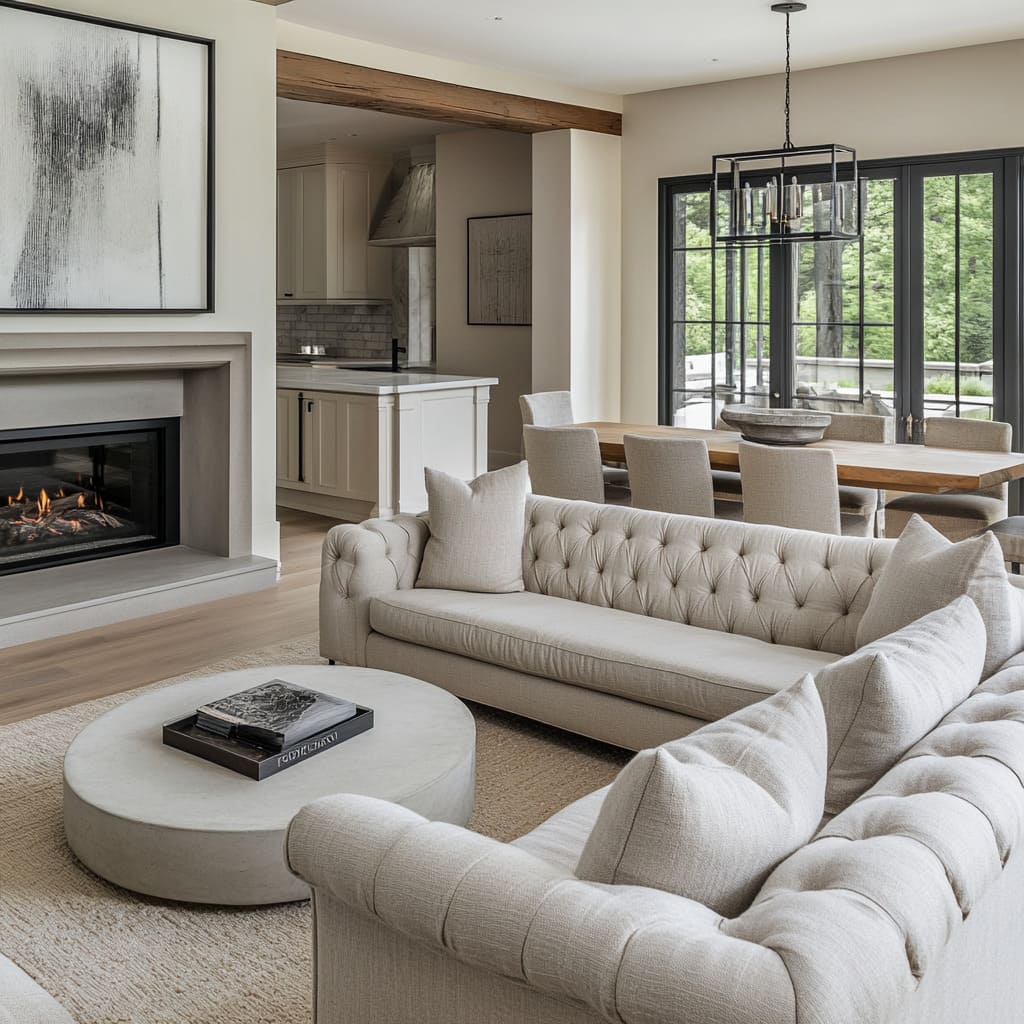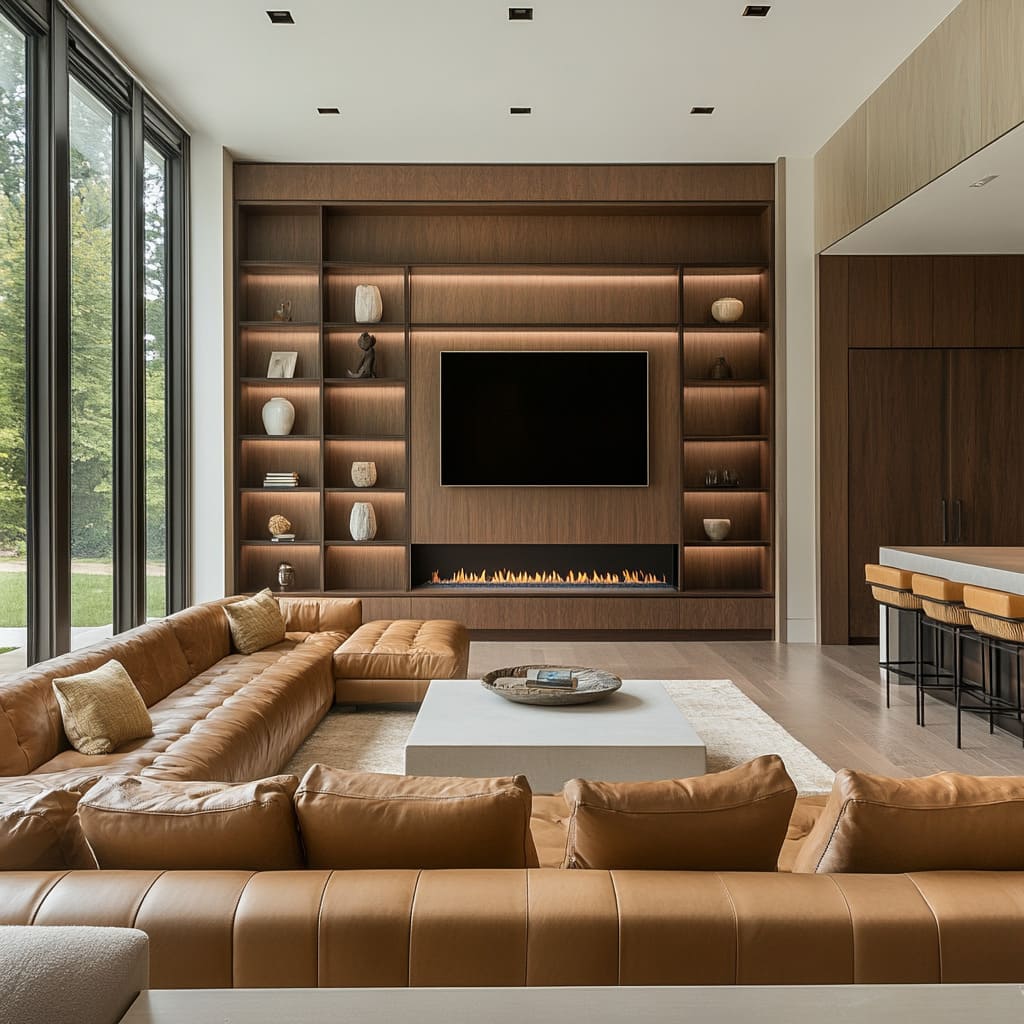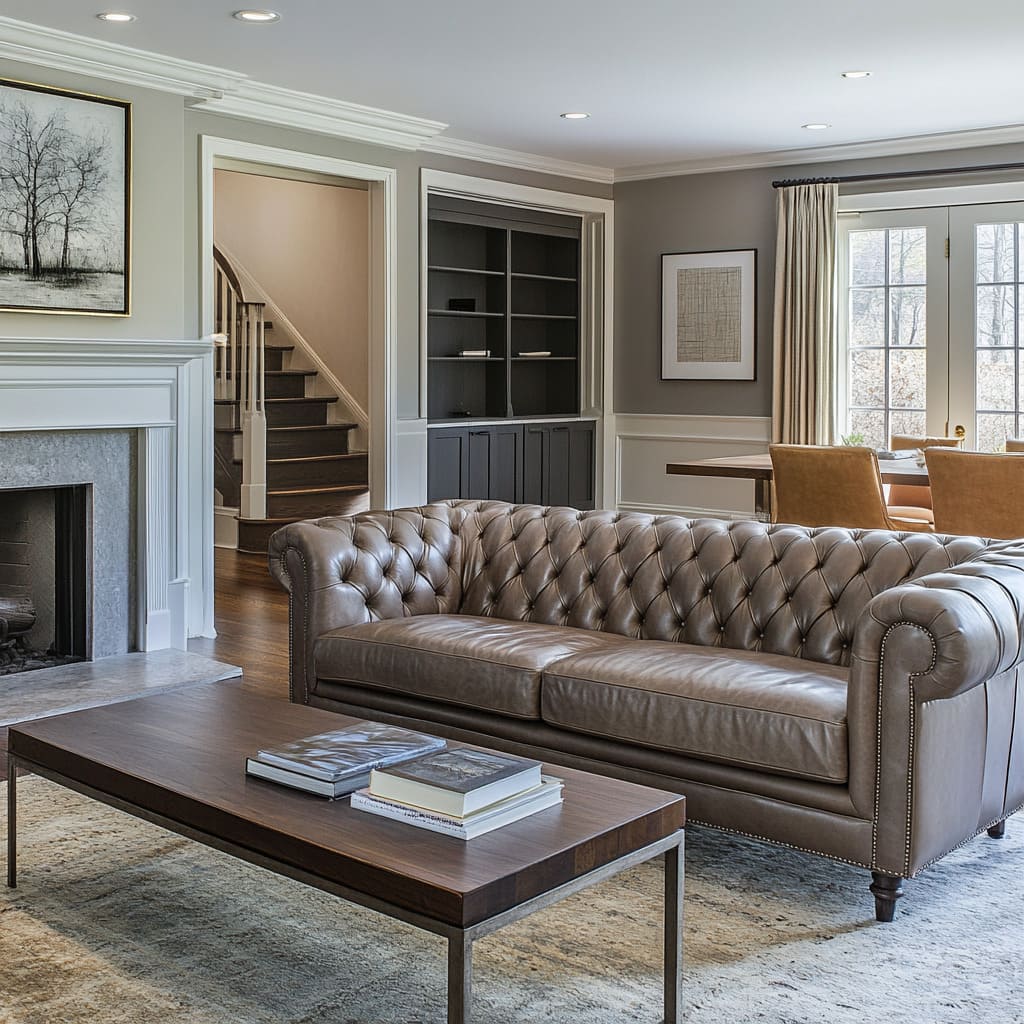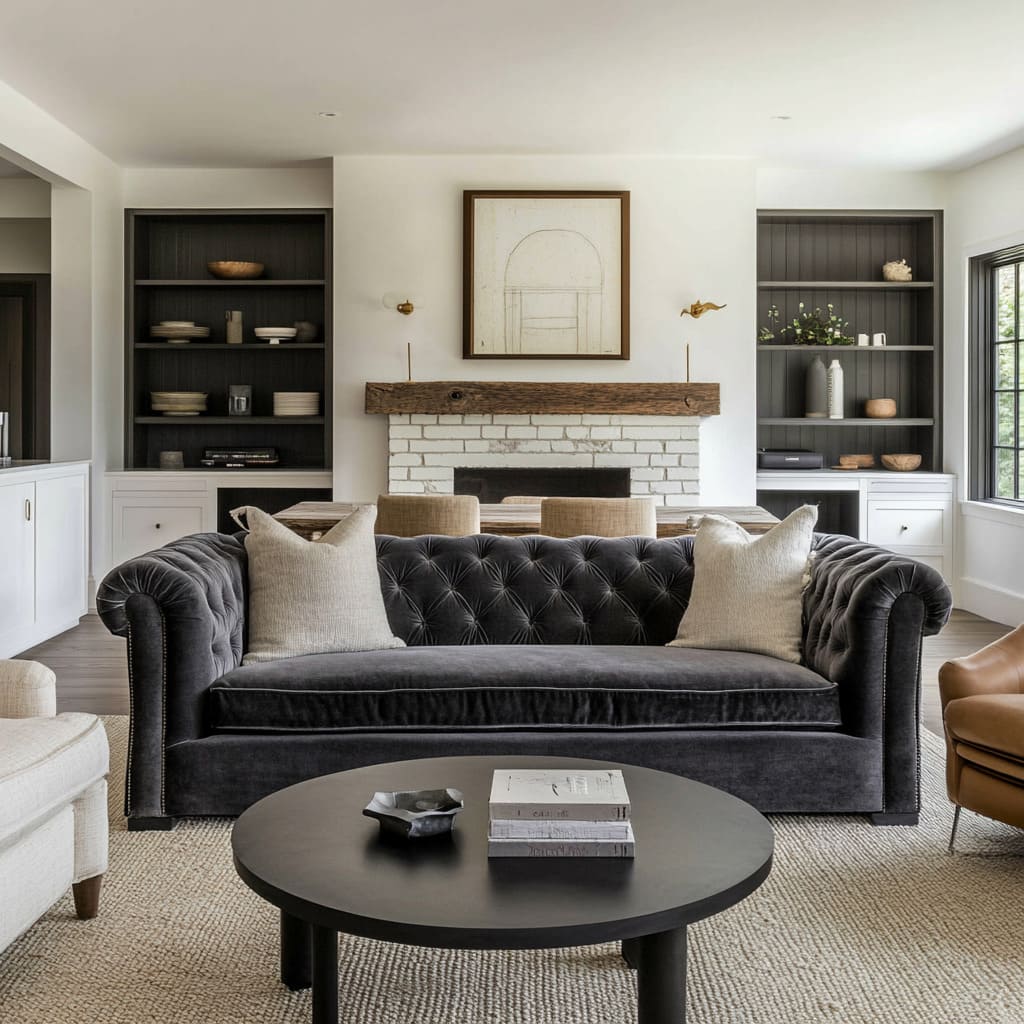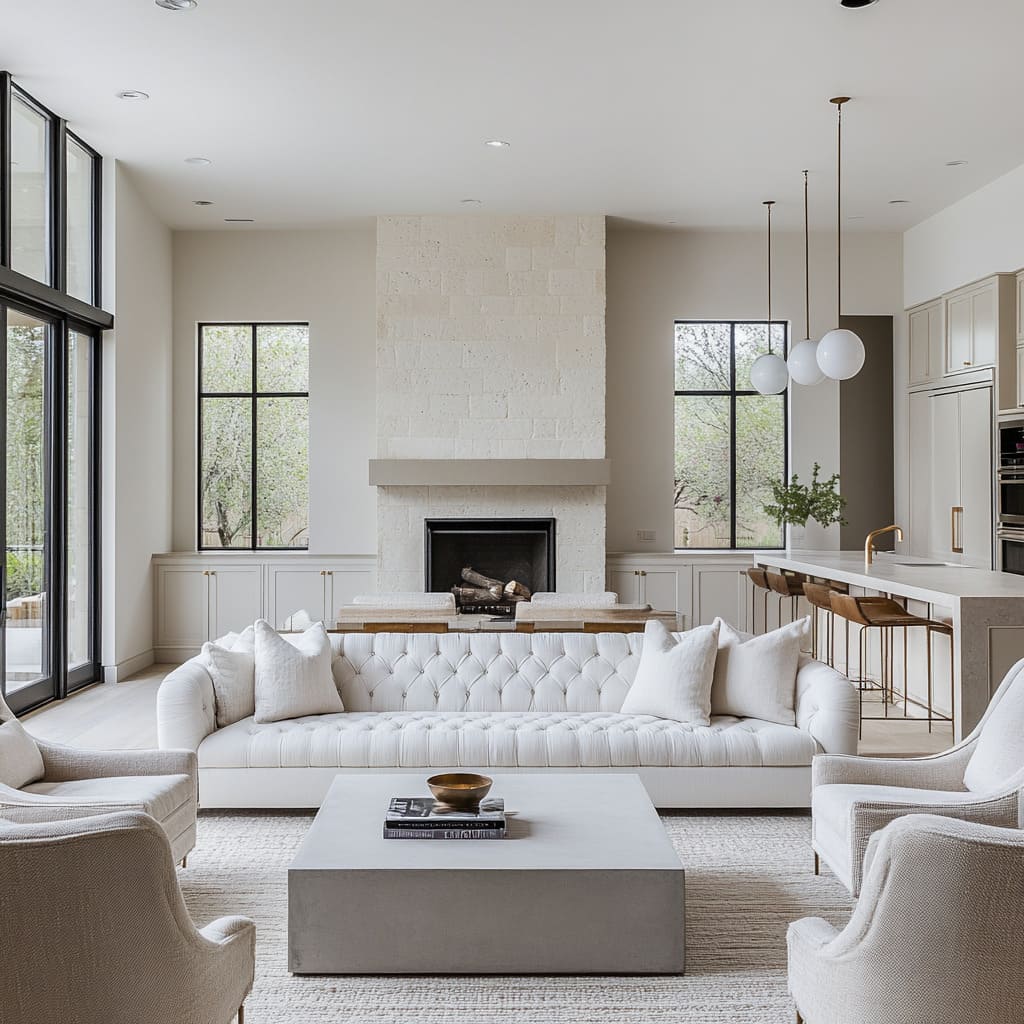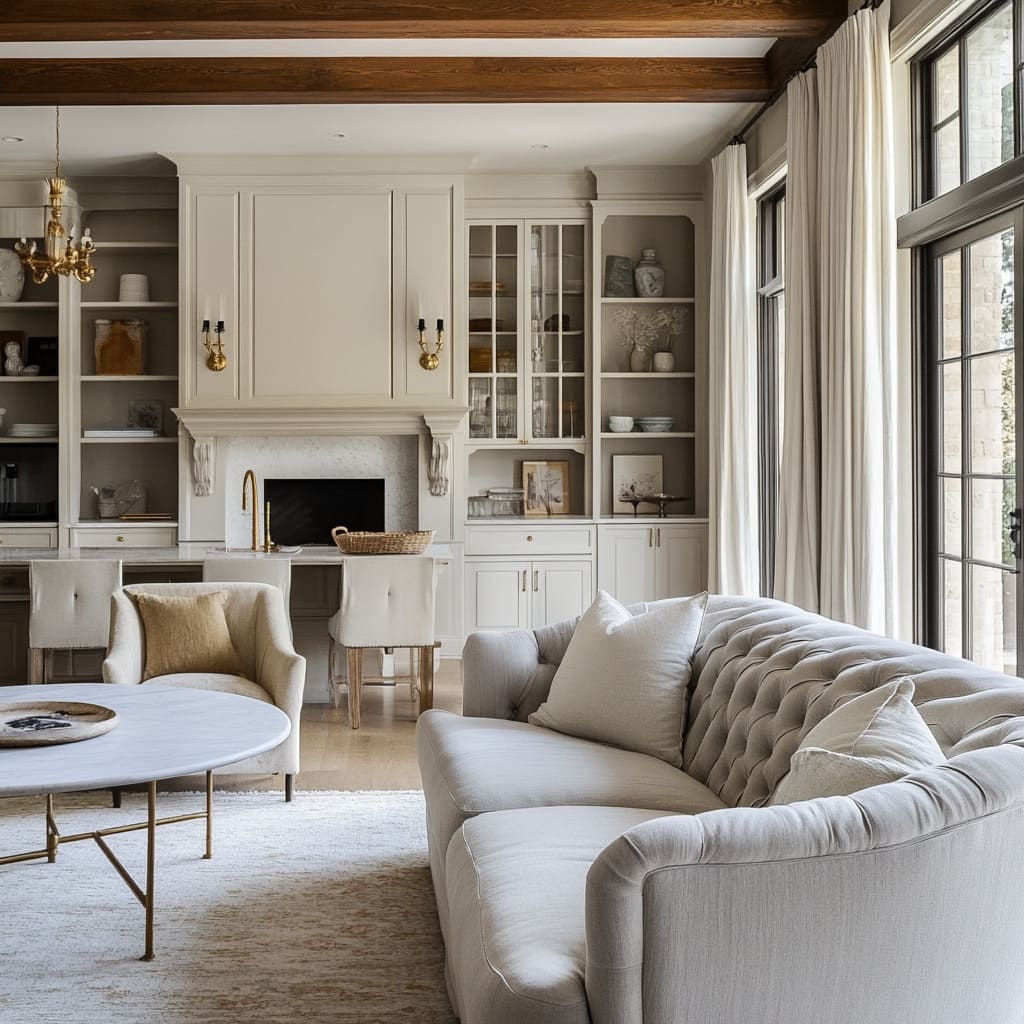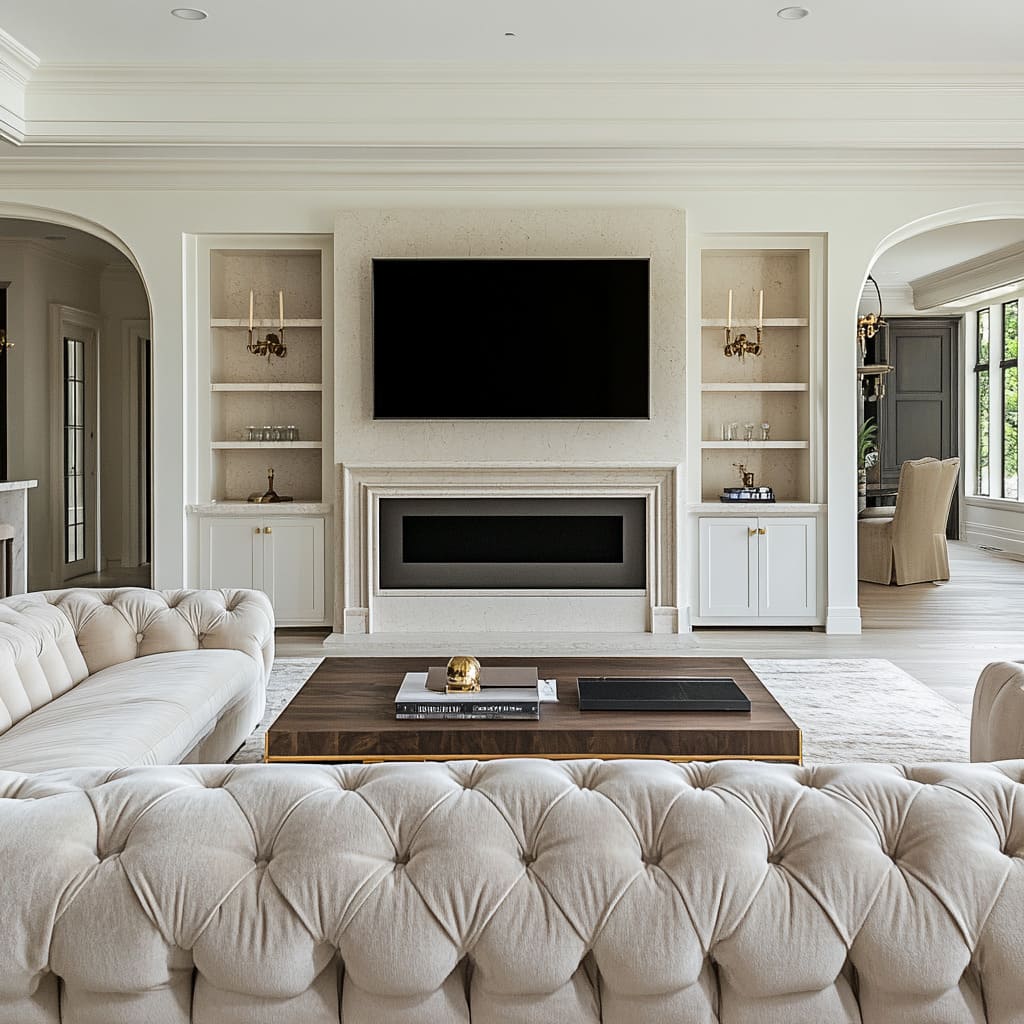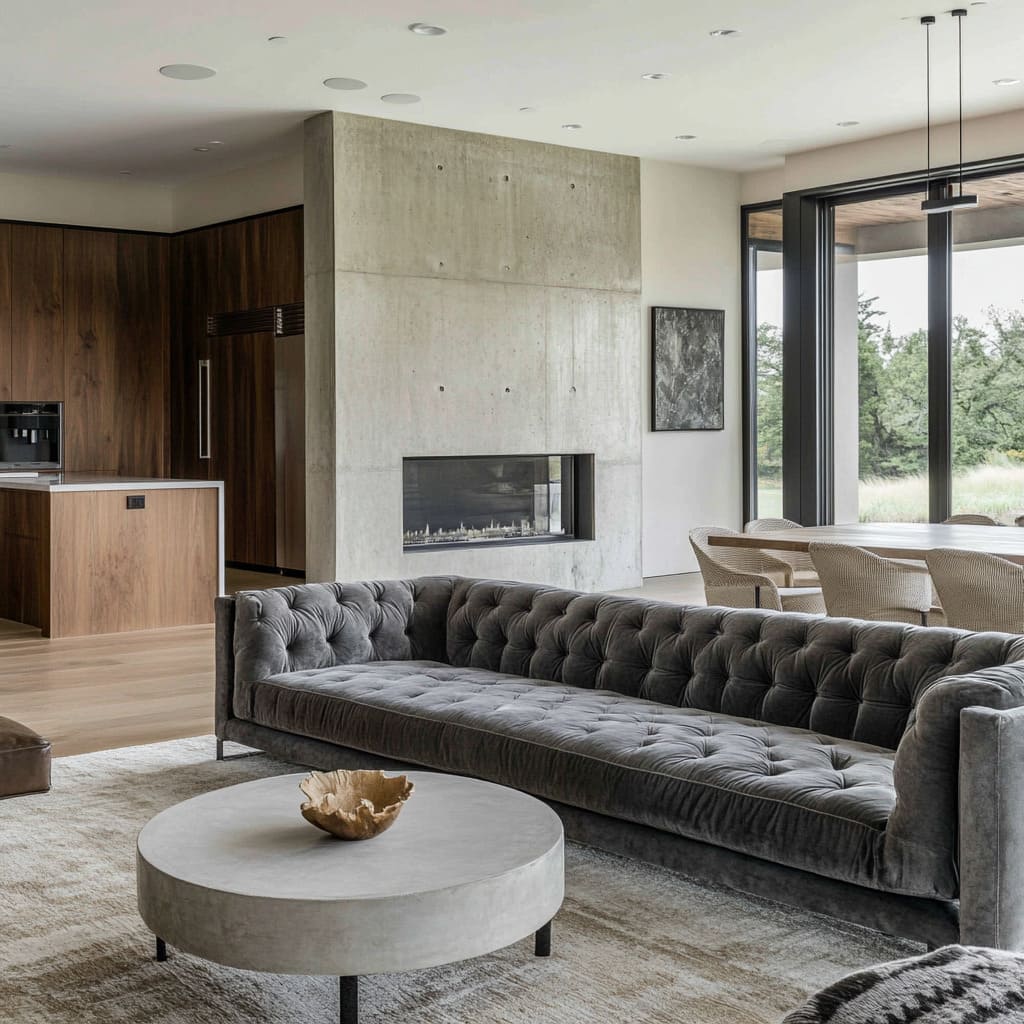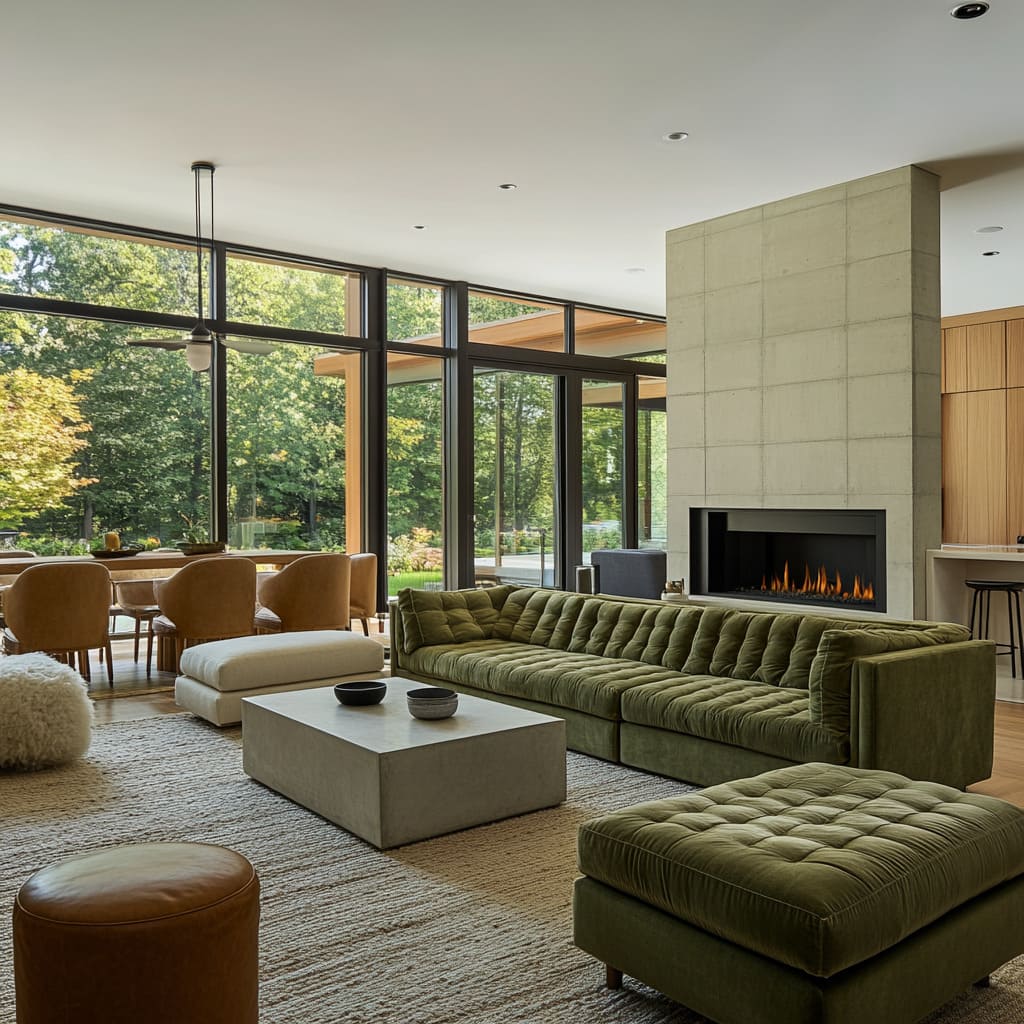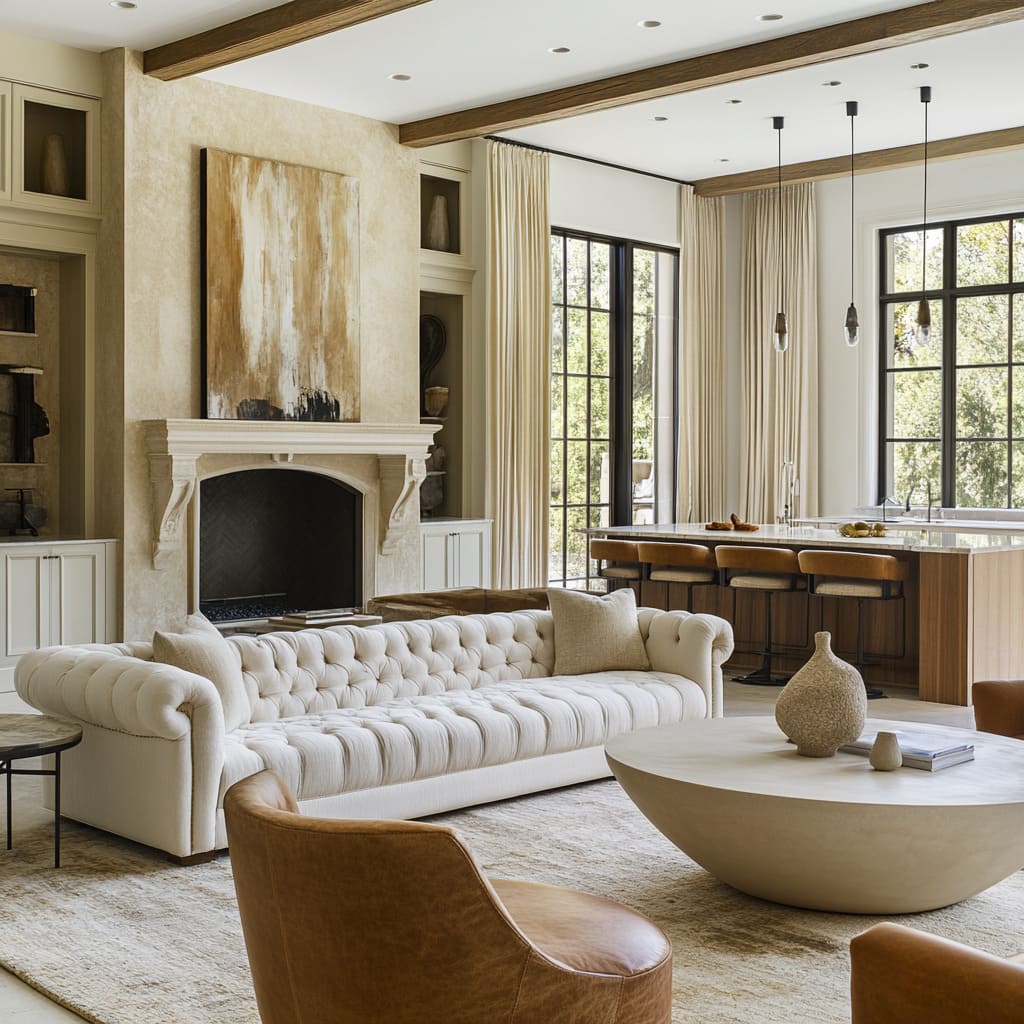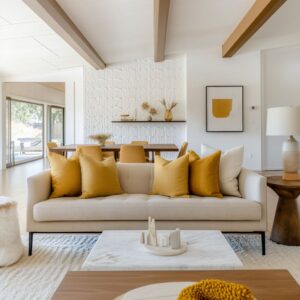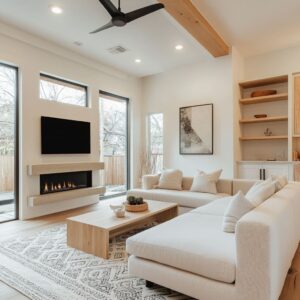This article offers an in-depth look at how designers are working with Chesterfield sofas in modern interiors. It’s not the usual surface-level discussion about button tufting and rolled arms.
Instead, this is a closer study of how subtle design changes and material choices are redefining the Chesterfield for today’s homes. Whether you’re searching for fresh chesterfield living room ideas or planning to rethink your existing space, these observations bring together insight from top design approaches across the U.S.
Sofas That Balance Old and New
The Chesterfield sofa has always been a symbol of tradition. But right now, designers are proving that it still belongs in contemporary homes—without feeling stuck in the past.
Across many modern interiors, you’ll find the Chesterfield taking on cleaner lines and lighter forms while holding onto the classic features that make it iconic. The trick is all in the details.
Reduced Tufting & Streamlined Profiles
One of the most noticeable updates to the Chesterfield is how the tufting has been handled. Instead of deep button tufting covering every inch of the sofa, designers are scaling it back.
Many new versions feature smooth seat cushions with no tufting at all. Others apply it only to the backrest, and even then, it’s done with shallow buttons.
This makes the sofa feel lighter and less fussy—perfect for open-concept spaces and minimalist settings. The look leans more toward sleek than ornate, helping it fit seamlessly with other modern furniture choices.
This shift isn’t random. Designers in places like California and New York suburbs are favoring pieces that blend tradition with a streamlined, contemporary appeal.
The Chesterfield, with its simplified tufting, slots right into these interiors. It’s an easy way to add a little structure to a space without making it look formal.
Reinterpreted Arm Styles
Another significant update is the arms. The traditional rolled arm is no longer a requirement.
Instead, slimmer, squared-off arms are becoming the norm. Some designs even taper the arms slightly for a more tailored shape.
This makes the sofa less bulky and easier to pair with other furniture. In open-plan homes where living, kitchen, and dining areas blend together, a lower-profile Chesterfield with clean arms keeps sightlines open and spaces feeling cohesive.
For anyone looking for chesterfield sofa ideas that feel current, this detail alone can change the entire look of a room. Squared arms give the sofa a modern edge, and they also make the Chesterfield easier to fit into tighter spaces, like city apartments or smaller family rooms.
Low-Back vs Higher-Back Choices
Back height is another area where designers are making careful decisions. The majority of today’s Chesterfields are built with lower backs, which help them feel more relaxed and less imposing in a room.
A low-back profile works well in homes where you want the sofa to blend into the flow of an open layout rather than stand out as a divider. But interestingly, some designers are going in the opposite direction.
In homes where the Chesterfield is used to separate spaces—like between a kitchen and living area—a higher back provides a clear boundary without needing a wall. It can also offer more support for lounging, especially in deeper-seated versions.
The back height, while subtle, is one of those factors that can define how a Chesterfield functions in a space—whether it’s a casual family hangout or a more formal entertaining area.
Palette and Material Shifts
One of the smartest updates to the Chesterfield sofa in today’s homes is the thoughtful choice of materials and colors. The old-school vibe of dark, glossy leather has taken a back seat to softer tones and textures that feel current and more adaptable to different styles.
These shifts aren’t just about looks; they play a big role in making the Chesterfield an easy fit for contemporary spaces.
Leather with a Subtle Sheen or Matte Finish
Leather is still a popular pick for a Chesterfield, but it’s being used in a way that feels understated and relaxed. Rather than the heavy shine of traditional versions, designers are leaning into matte finishes or lightly distressed leathers.
Shades like camel, taupe, charcoal, and sand are leading the way. They sit in that sweet spot—not too dark, not too light—and bring warmth without feeling too formal.
A camel-colored leather Chesterfield, for example, adds an inviting tone that works perfectly in open living spaces with oak flooring and pale walls. These finishes help tone down the formality that can come with a leather sofa, making it easier to introduce into a wider variety of homes.
Linen and Velvet Variations
For people leaning toward a softer or more relaxed feel, linen has become a top choice. Neutral shades like ivory, light gray, and stone are common, often paired with a slightly textured weave.
This breaks up the flat look and adds a bit of depth. Velvet Chesterfields have also made a quiet comeback, but in a subtle way.
Muted olives, deep charcoals, and pale ivory velvets bring just enough sheen to create interest without overpowering a room. These options are especially popular in transitional interiors, where a little luxury is welcomed, but the overall goal is comfort and simplicity.
Coordinated Undertones
A closer look at many modern chesterfield sofa living room ideas shows how designers are connecting the color of the sofa with other pieces in the room. You’ll often see camel leather echoed in bar stool upholstery or wood tones that have the same warmth.
An olive green velvet Chesterfield might be paired with ceramics or woven stools in complementary shades. This subtle matching of undertones helps tie an entire open living space together without relying on obvious color coordination.
Strategic Use of Textiles
Textiles are playing a huge role in how today’s Chesterfield sofas are styled in living spaces. Designers are paying close attention to what goes underfoot, how layers are built, and how different textures interact with the sofa’s finish.
Layered Rugs
In most modern interiors that feature a Chesterfield, you’ll find more than one rug at play. A base layer, usually a natural fiber like wool or jute, sets the tone.
On top of that, there’s often a second layer—sometimes a softer, thicker pile rug or one with subtle patterns. This combination brings a cozy, lived-in feel while adding dimension.
It’s a smart way to soften the look of a structured Chesterfield without losing its strong presence. This layered approach is showing up in homes everywhere, from relaxed farmhouse living rooms to sophisticated suburban spaces.
Vintage & Kilim Influence
Another strategy popping up in chesterfield sofa living room ideas is the use of vintage rugs or kilims in muted colors. A faded kilim in soft reds, blues, or earthy tones can break up a room that’s heavy on neutrals.
It gives just enough color and pattern to make the space feel collected and personal. Paired with a neutral Chesterfield, this rug choice creates an easy balance between traditional and contemporary styles.
These textiles often have the added benefit of telling a story, giving the space a sense of character without being overly busy.
Coffee Tables as Design Bridges
A Chesterfield sofa naturally draws attention, but what anchors the entire seating area is often the coffee table. Designers are using coffee tables not only for function but as a link between materials and styles within a space.
The right table can create balance, adding texture or weight where it’s needed.
Concrete & Travertine for Organic Weight
One of the standout trends in chesterfield lounge ideas is pairing these iconic sofas with concrete or travertine coffee tables. These tables bring a solid, grounded feel to the room.
Their subtle texture complements the Chesterfield’s tufted details without competing for attention. Whether round or rectangular, the weight of these materials gives the living area a strong visual anchor—especially important in open-plan spaces where definition can get lost.
Travertine’s natural color variations also bring a softness that contrasts nicely with the clean lines of a modern Chesterfield. Concrete tables are showing up often in transitional and contemporary spaces across the country, particularly in homes where the mix of organic textures and clean lines is a key part of the design language.
Wood Tables with Minimalist Bases
Wood coffee tables, especially those made from reclaimed oak or finished with a wire-brushed surface, are another popular choice. These tables tend to pick up the tone or grain of other wood elements in the space—like a fireplace mantel, open shelving, or flooring.
This subtle coordination keeps the room feeling cohesive without being too matched. Designers frequently opt for simple, minimalist bases to keep the focus on the natural texture of the wood.
In a Chesterfield seating area, this choice helps bridge the gap between traditional and modern styles, making the whole arrangement feel intentional and seamless.
Accent Chairs that Soften Angles
While a Chesterfield sofa brings strong lines and structure to a room, it often needs something to balance that presence. Accent chairs are doing exactly that.
Whether they’re soft and rounded or designed to swivel, they add a sense of ease and comfort, preventing the space from feeling too formal.
Curved Boucle Chairs
One of the most popular chesterfield sofa decorating ideas today is placing curved chairs opposite the sofa. Designers often go for boucle upholstery in cream or white, which adds texture and softness.
These chairs break up the Chesterfield’s angularity with their rounded forms. The contrast between a clean-lined Chesterfield and a pair of curved, plush chairs creates a dynamic look that feels balanced and comfortable.
It’s a combination you’ll see often in living rooms styled with a casual, yet polished vibe—especially in suburban homes where comfort is as important as style.
Swivel vs Stationary
Swivel chairs are becoming an easy solution in open-concept spaces. Their ability to rotate means you can face the fireplace, turn toward the TV, or spin around to chat with someone at the kitchen island.
This makes them practical without looking like office furniture. In contrast, stationary chairs offer structure and work well in spaces where the layout stays consistent.
Designers are using both options, depending on the flow of the room, but the key is always about keeping things inviting and flexible. In Chesterfield living areas, swivel chairs help create zones that feel connected but not rigid.
Fireplace Walls & Entertainment Niches
The area behind a Chesterfield sofa plays a big role in shaping the atmosphere of the living room. Designers are using fireplace walls and entertainment niches as key focal points, often tying them directly into the sofa’s shape and color.
These features are never an afterthought—they’re thoughtfully integrated to complement the Chesterfield’s silhouette.
Linear Fireplaces for a Streamlined Match
One approach gaining traction is the use of linear fireplaces. These stretch horizontally across a feature wall, often finished in smooth plaster or concrete.
The long, low profile echoes the clean lines of a modern Chesterfield, creating a balanced focal point. In homes with open layouts, this pairing works especially well, keeping the living area cohesive and simple without losing visual interest.
A slimline fireplace helps the room feel grounded while matching the scale of the furniture.
Integrated TVs
Entertainment setups are evolving. Instead of clunky media units or oversized TV frames, flush-mounted screens are becoming standard.
Designers often recess the television directly above the fireplace or in an adjacent niche, making sure the screen doesn’t steal the show. Thin bezels or frameless styles keep the look minimal.
Floating mantels in pale oak or stone sometimes sit just beneath, adding a subtle horizontal line that mirrors the shape of the Chesterfield. It’s a smart way to keep the focus balanced across the entire room, letting the seating area remain the centerpiece.
Built-Ins & Shelving
On either side of these modern fireplaces, custom shelves and cabinets are common. Designers favor materials like white oak or walnut to connect the living space to the kitchen or dining area.
The shelves are often styled with intention: ceramic vases, a few stacked books, and the occasional sculptural piece. It’s about restraint—never overcrowded.
This approach adds layers of texture without taking attention away from the main seating area. Many chesterfield sofa inspiration ideas pull from this method, using simple built-ins to frame the furniture and make the room feel complete.
Lighting Choices
Lighting can make or break the mood in a living room. For spaces built around a Chesterfield sofa, designers are taking a subtle but thoughtful approach.
Lighting doesn’t have to be loud to have impact. Instead, it works behind the scenes to create a warm, comfortable environment.
Pendant Clusters & Chandeliers
In open-plan homes, pendant lights or chandeliers are used to draw the eye upward and define separate areas without walls. Over a dining table or floating above the living room, these fixtures bring balance to the space.
Linen or glass shades are popular choices because they soften the light, which is important in rooms where strong architectural elements—like a Chesterfield—are already making a statement. Brass or blackened steel finishes often echo the kitchen hardware nearby, ensuring everything works together without feeling overly coordinated.
It’s a detail seen often in chesterfield sofa living room design ideas, where lighting plays a supporting role rather than taking center stage.
Discrete Floor Lamps
A well-placed floor lamp next to the Chesterfield adds a focused glow. The most popular versions feature linen shades and slender metal or wood frames.
These lamps are practical for reading but also help build a cozy atmosphere in the evening. Rather than relying on ceiling lights, floor lamps add depth and warmth to the room.
They work especially well in open layouts where softer pools of light create zones without using physical dividers. Designers often pair these with subtle overhead lighting, ensuring the space stays bright but never harsh.
Connection to Kitchen & Dining
One of the standout features in homes where a Chesterfield takes center stage is the effortless flow between the living area, kitchen, and dining space. Designers are creating a smooth connection between these zones by repeating finishes, materials, and colors, making the entire space feel cohesive without forcing a match.
Visual Continuity Through Materials
In many modern layouts, the same flooring runs from the living space straight into the kitchen. Whether it’s pale oak, wide-plank hardwood, or polished concrete, this approach visually ties the spaces together.
The Chesterfield sofa, often placed on an area rug, feels integrated rather than separate. It’s this seamless transition that makes open layouts feel intentional.
And in a room with a chesterfield sofa modern interior design theme, this kind of material continuity enhances the simplicity and flow designers aim for.
Matching Hardware & Stool Finishes
Designers are also smart about using small details to connect the rooms. Kitchen hardware—like brushed brass pulls or matte black faucets—often finds an echo in the living room through side table legs, lamp bases, or picture frames.
Leather bar stools at the kitchen island frequently mirror the color of the Chesterfield. If there’s a camel leather sofa in the living room, chances are the stools will pick up the same tone.
These subtle choices make the space feel pulled together, like everything belongs without feeling overdone.
Island Overlook
In open concepts, the Chesterfield is often placed with its back to the kitchen island, facing either a fireplace or an entertainment wall. This setup allows conversation to flow easily between both spaces.
Whether someone’s cooking at the island or sitting on the sofa, everyone stays connected. It’s one of the reasons the Chesterfield works so well in these homes—its structured back looks good from every angle.
Whether you’re coming in from the front door or hanging out at the kitchen island, the sofa still makes a statement.
Subtle Modern Moves
Modern Chesterfields often sit in rooms with an understated design approach. These spaces focus on simplicity, clean lines, and thoughtful details that keep everything feeling fresh without shouting for attention.
Designers are using a handful of quiet strategies to achieve this look.
Monochrome Artwork
Large-scale black-and-white art is often placed above or near the Chesterfield. These pieces typically have thin frames or are mounted without frames at all.
They reflect the sofa’s updated, streamlined silhouette. Neutral palettes, whether abstract or photographic, reinforce the calm and balanced feel of the room.
It’s a smart way to add interest without pulling focus from the furniture.
Minimal Window Treatments
In many of today’s upscale homes, windows are left open to flood the space with natural light. When window coverings are used, they’re usually light linen panels or simple sheers that frame the view rather than block it.
Heavy drapery would fight against the clean lines and simple materials most designers are aiming for. Minimal treatments help keep the focus on textures—like the leather or linen upholstery of the Chesterfield—and the subtle beauty of the finishes throughout the room.
Soft Division for Office Corners
With open-concept living becoming the standard, there’s often a need for a workspace that doesn’t feel like an office. Some homes use the back of the Chesterfield to define a small office nook without adding walls.
A floating desk, a simple chair, and a few shelves can tuck into this space nicely. The sofa acts as a gentle divider, keeping the work zone separate without interrupting the flow of the room.
This setup works especially well in family homes where multi-tasking spaces are key, adding to the flexibility that modern living requires.
Overarching Observations
After breaking down the details, certain design patterns stand out in how Chesterfield sofas are styled for modern spaces. These choices are subtle but make a huge difference in how the sofa works within an open floor plan.
Scaling Down and Simplifying
One of the clearest updates is the shift toward sleeker shapes. Today’s Chesterfields often come with slimmed-down arms, lower backs, and tufting that’s been scaled back.
These edits strip away the bulk, making the sofa feel lighter and better suited to homes with open layouts. Whether it’s placed in a suburban living room or a city townhouse, this version of the Chesterfield fits right in without overpowering the space.
Textural Play
A big part of these interior design ideas with a chesterfield sofa is layering texture. You’ll often see the contrast between the smooth leather or linen of the Chesterfield and surrounding materials like boucle chairs, thick wool rugs, and concrete coffee tables.
This variety keeps the space interesting without cluttering it up. Texture takes center stage where color palettes are kept simple, creating depth and warmth through surfaces instead of patterns.
Tone Harmony
Rather than bold color schemes, designers focus on tonal balance. The color of the Chesterfield—whether camel, charcoal, or olive—often pops up again in other parts of the room.
You might find it repeated in bar stool leather, cabinetry hardware, or even the tones of the area rug. This approach keeps everything feeling cohesive, but never flat or forced.
It’s about creating a quiet link between pieces instead of a theme that shouts for attention.
Soft Boundaries
In homes where living, dining, and kitchen areas merge into one space, a Chesterfield often acts as a soft boundary. Its structured back gives a sense of where one area ends and another begins—without adding walls or partitions.
It works like a visual marker, giving each zone its own identity while keeping the flow wide open.
Mix of Natural & Industrial Surfaces
Another standout move is pairing natural elements with industrial ones. You’ll often see Chesterfields sitting comfortably alongside plaster walls, steel light fixtures, concrete hearths, and stone coffee tables.
But these harder materials are balanced by warm oak floors, linen drapes, and soft wool rugs. The Chesterfield, especially in leather or linen, bridges these two worlds perfectly, keeping the space from feeling too cold or too rustic.
Final Thought
The Chesterfield has always been a symbol of tradition, but now it’s getting a modern refresh. Designers are simplifying the silhouette—adjusting the arms, scaling back the tufting—and pairing it with laid-back materials like concrete, oak, boucle, and wool.
The result is a living space that feels current, comfortable, and inviting, while still giving a respectful nod to the sofa’s roots. It’s clear why this piece remains a favorite: it adapts beautifully, whether you’re styling a casual family room or a more polished open-plan home.
